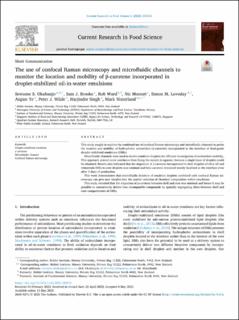| dc.contributor.author | Okubanjo, Sewuese | |
| dc.contributor.author | Brooke, Sam J. | |
| dc.contributor.author | Ward, Rob | |
| dc.contributor.author | Mostert, Nic | |
| dc.contributor.author | Loveday, Simon M. | |
| dc.contributor.author | Ye, Aiqian | |
| dc.contributor.author | Wilde, Peter J. | |
| dc.contributor.author | Singh, Harjinder | |
| dc.contributor.author | Waterland, Mark | |
| dc.date.accessioned | 2024-03-13T12:49:08Z | |
| dc.date.available | 2024-03-13T12:49:08Z | |
| dc.date.created | 2023-06-02T13:17:07Z | |
| dc.date.issued | 2023 | |
| dc.identifier.citation | Current Research in Food Science (CRFS). 2023, 6 . | en_US |
| dc.identifier.issn | 2665-9271 | |
| dc.identifier.uri | https://hdl.handle.net/11250/3122147 | |
| dc.description.abstract | This study sought to explore the combined use of confocal Raman microscopy and microfluidic channels to probe the location and mobility of hydrophobic antioxidant (β-carotene) incorporated at the interface of food-grade droplet-stabilized emulsions (DSEs).
Microfluidic channels were used to isolate emulsion droplets for efficient investigation of antioxidant mobility. This approach proved more conclusive than fixing the sample in agarose, because a single layer of droplets could be obtained. Results also indicated that the migration of β-carotene incorporated in shell droplets of olive oil and trimyristin DSEs to core droplets was minimal and beta-carotene remained mostly localised at the interface even after 3 days of production.
This work demonstrates that microfluidic isolation of emulsion droplets combined with confocal Raman microscopy can give new insights into the spatial variation of chemical composition within emulsions.
This study revealed that the migration of β-carotene between shell and core was minimal and hence it may be possible to concurrently deliver two incompatible compounds by spatially segregating them between shell and core compartments of DSEs. | en_US |
| dc.language.iso | eng | en_US |
| dc.publisher | Elsevier B. V. | en_US |
| dc.rights | Navngivelse 4.0 Internasjonal | * |
| dc.rights.uri | http://creativecommons.org/licenses/by/4.0/deed.no | * |
| dc.title | The use of confocal Raman microscopy and microfluidic channels to monitor the location and mobility of β-carotene incorporated in droplet-stabilized oil-in-water emulsions | en_US |
| dc.title.alternative | The use of confocal Raman microscopy and microfluidic channels to monitor the location and mobility of β-carotene incorporated in droplet-stabilized oil-in-water emulsions | en_US |
| dc.type | Peer reviewed | en_US |
| dc.type | Journal article | en_US |
| dc.description.version | publishedVersion | en_US |
| dc.source.volume | 6 | en_US |
| dc.source.journal | Current Research in Food Science (CRFS) | en_US |
| dc.identifier.doi | 10.1016/j.crfs.2023.100515 | |
| dc.identifier.cristin | 2151232 | |
| dc.source.articlenumber | 100515 | en_US |
| cristin.ispublished | true | |
| cristin.fulltext | original | |
| cristin.qualitycode | 1 | |

